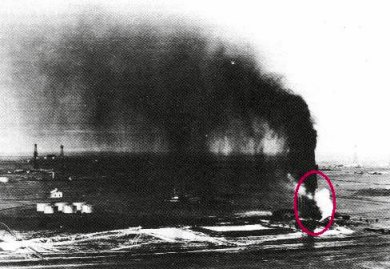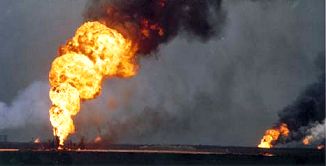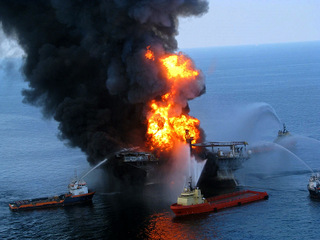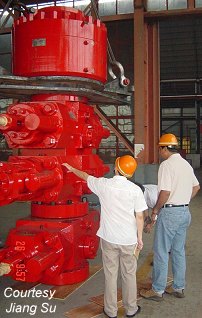Over-Pressured Zones
“Gushers” and Blowouts
Oil and gas exist in underground traps under great pressure in “over-pressured” zones. When the formation containing the oil or gas is penetrated by the drill bit, the oil and gas can potentially blast out of an over-pressured zone with great force.

“Wild Mary Sudik” – An Early Gusher — Drilled By The Indian Territory Illuminating Oil Company (ITIO)
In the early days of petroleum drilling, there was no good way to drill holes and simultaneously keep this great force under control. At the left, a well is shown “blowing wild”. This means that the tremendous gas pressure in the reservoir thousands of feet below the ground is forcing huge amounts of oil up the hole, blowing it into the air. This blowout is sometimes called a “gusher.”
The circled well is the Mary Sudik #1, drilled by the Indian Territory Illuminating Oil Company (ITIO) in Oklahoma. On March 26, 1930, this well blew out at 6,470 feet. The force blew 20 pieces of very heavy drill pipe out of the hole! Each piece of drill pipe was 30 feet long.
The “Wild Mary Sudik” was finally plugged off 11 days after blowing out, through the heroic efforts of dozens of people. Six years later, the Sudik lease had produced five million barrels of oil!
Recent “Gushers”

Kuwati Well Fires – Result of War Damage
During the 1991 Gulf War, the retreating Iraqi soldiers dynamited the wellheads off more than six hundred Kuwati oil wells, creating one of the biggest man-made environmental disasters in history. Since most Kuwati wells flow without pumps under their own great pressure, the oil and gas erupted from the ground with tremendous force. It was first estimated that it would take 2 years to repair all the wells. However, the heroic and extremely dangerous job was actually done in about six months.

Deepwater Horizon Blowout
In 2010, the British Petroleum (BP) Deepwater Horizon rig was drilling a well in approximately 5,000 feet (1.5 km) of water in the Gulf of Mexico. When the bit hit a dangerously over-pressured zone, gas escaped up the borehole and ignited at the surface. The rig then collapsed. Subsequently, attempts were made to close the various blowout preventers at the sea floor, but the attempts failed. Finally, the well was shut in approximately 3 months later.
In addition to being one of the most dangerous situations humans can face, as well as an much-unwanted environmental problem, a blowout is considered very bad for the environment, and very bad for business. Most companies make a tremendous effort to avoid spilling a single drop of oil on the ground — or in the water.
Blowout Preventers (BOP’s)

A Blowout Preventer
“Blowouts” have been extremely rare for over 90 years. Blowout preventers (BOP’s) were invented in the 1920’s that allowed the drilling crew to keep the well under control at all times. The BOP came into very wide use in the 1930’s.
There are several types of blowout preventers. They are often combined into one BOP, such as the one at the left. There is an annular BOP at the top. Below that are three ram-type BOP’s.
A Blowout Preventer, or BOP, is an important tool used in oil and gas drilling to keep everything safe. Think of it like a strong safety valve that stops dangerous pressures and fluids from escaping when drilling a hole in the ground. Here’s how it works and the different types of BOPs:
How They Work:
When drilling a well for oil or gas, workers use a thick liquid called drilling mud. The weight of the mud helps control the pressure inside the well. Sometimes, the pressure from the oil or gas deep underground can be much stronger than the pressure from the mud. If that happens, it can cause a blowout, which is when oil or gas bursts out uncontrollably.
The BOP’s job is to stop this from happening. If it senses that the pressure is getting too high, it quickly closes off the well to keep everything safe.
Types of Blowout Preventers
- Annular Blowout Preventer (Annular BOP):
- How It Looks: This type has a special rubber-like seal that can stretch and squeeze.
- How It Works: It seals around the drilling pipe and even around an empty hole. When it closes, it keeps pressure and fluids from escaping. It’s very flexible and can quickly adjust to different sizes, making it useful for various drilling situations.
- Ram Blowout Preventer (Ram BOP):
- How It Looks: This type has strong metal pieces called rams that move in and out.
- How It Works: When the pressure gets too high, the rams push together to seal the well. There are different kinds of rams:
- Blind Rams: These seal the well completely when no pipe is in it.
- Pipe Rams: These seal around the drilling pipe, grabbing it tightly.
- Shear Rams: These are strong enough to cut the pipe if it’s stuck and then seal the well at the same time.
- Stacked Blowout Preventers:
- How It Looks: This is a setup where multiple BOPs are stacked on top of each other.
- How It Works: Having several types of BOPs together gives extra safety. If one doesn’t work for some reason, another can still help keep the well sealed.
- Subsea Blowout Preventers:
- How It Looks: These are specifically made to work underwater at ocean drilling sites.
- How It Works: They work similarly to other BOPs but are designed for the special challenges of underwater pressure. ROVs (remote-operated vehicles) often control them because they are deep down and hard to reach.
Why are BOPs Important?
Blowout Preventers are very important because they help prevent accidents. If not controlled, a blowout can lead to dangerous situations, including fires, oil spills, and harm to people and the environment. Everyone involved in drilling needs to understand how to use BOPs properly to keep things safe.
In summary, a Blowout Preventer is like a safety device that keeps everything secure when drilling for oil or gas, preventing dangerous situations and protecting workers and the environment.
